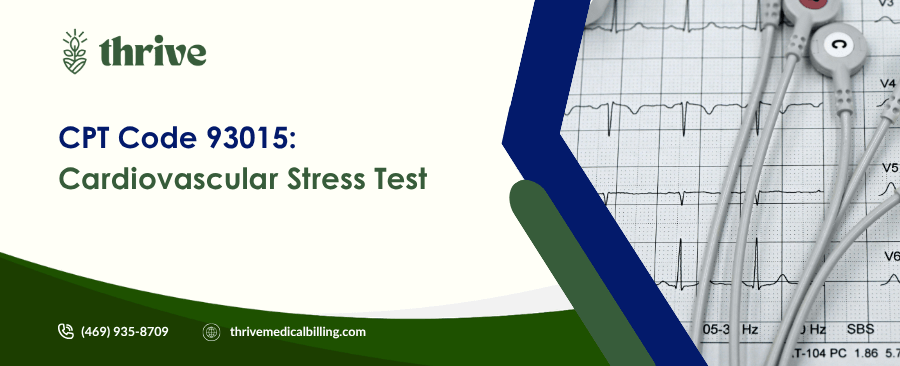Introduction to 93015 CPT Code Description
CPT code 93015 is a procedural code used in medical billing to describe a cardiovascular stress test using a treadmill or bicycle exercise, with continuous electrocardiographic (ECG) monitoring, physician supervision, interpretation, and reporting. This code is part of the Current Procedural Terminology (CPT) system maintained by the American Medical Association (AMA) and is widely used in cardiac evaluation to assess heart function under stress. Understanding the 93015 CPT code description is essential for cardiologists, healthcare providers, and billing professionals to ensure accurate billing and avoid issues that lead to claim denials.
This guide provides a detailed overview of CPT code 93015, its applications, modifiers, Medicare reimbursement rates, and strategies to optimize billing for cardiovascular stress testing procedures addressing various cardiac conditions.
What is a Cardiovascular Stress Test and CPT Code 93015?
A cardiovascular stress test, also known as an exercise stress test, evaluates the heart’s response to physical exertion, typically using a treadmill or stationary bicycle. CPT code 93015 encompasses the global service of this procedure, including:
- Physician supervision during the test.
- Continuous ECG monitoring to track heart rhythm and electrical activity.
- Interpretation and reporting of the results by a qualified healthcare provider.
This code is used for cardiac evaluation in outpatient settings, such as hospitals, cardiology clinics, or diagnostic centers, to assess heart function in patients with symptoms like chest pain or shortness of breath. CPT code 93015 is the global code, meaning it covers both the technical (equipment and staff) and professional (physician interpretation) components of the test.
Procedure Involving CPT Code 93015
The procedure involving CPT code 93015 includes the following steps:
- Patient Preparation: The patient is connected to an ECG monitor, and baseline vital signs (e.g., heart rate, blood pressure) are recorded.
- Exercise Protocol: The patient performs physical exercise on a treadmill or bicycle, following a standardized protocol (e.g., Bruce or modified Bruce protocol) that gradually increases intensity.
- Continuous Monitoring: ECG, heart rate, and blood pressure are monitored continuously to detect abnormalities like arrhythmias or ischemic changes.
- Physician Supervision: A physician oversees the test to ensure patient safety and intervene if complications arise.
- Test Completion: The test ends when the patient reaches a target heart rate, experiences symptoms, or cannot continue due to fatigue or medical concerns.
- Interpretation and Reporting: The physician analyzes the ECG data, vital signs, and patient symptoms, then generates a report with findings and recommendations.
The procedure typically lasts 10–20 minutes, depending on the patient’s fitness level and clinical status. CPT code 93015 is used for the comprehensive service, distinguishing it from component-specific codes.
Comparison with Related CPT Codes
CPT code 93015 is part of the cardiovascular stress testing code set, which varies based on the components of the service. Here’s how it compares to related codes:
- CPT Code 93016: Covers physician supervision and interpretation only, without the technical component (e.g., equipment or staff).
- CPT Code 93017: Represents the technical component only, including tracing and equipment use, without physician supervision or interpretation.
- CPT Code 93018: Includes physician interpretation and reporting only, excluding supervision and technical components.
- CPT Code 93025: Describes a microvolt T-wave alternans test, a specialized stress test, distinct from the standard exercise test of 93015.
Choosing the correct procedural code is critical to ensure accurate billing. For example, billing CPT code 93015 when only the technical component (93017) was performed can lead to claim denials.
Modifiers for CPT Code 93015
Modifiers provide additional context for CPT code 93015 to ensure proper reimbursement. Common modifiers include:
- Modifier 26 (Professional Component): Used when billing only for the physician’s supervision, interpretation, and reporting, excluding the technical component (not typically used with 93015, as it is a global code).
- Modifier 52 (Reduced Services): Indicates a partially performed procedure, such as a test stopped early due to patient intolerance.
- Modifier 53 (Discontinued Procedure): Applied when the test is stopped for safety reasons, e.g., patient chest pain or severe arrhythmia.
- Modifier 59 (Distinct Procedural Service): Denotes a separate procedure on the same day, such as a stress test and an echocardiogram. Use cautiously to avoid unbundling issues.
- Modifier 76 (Repeat Procedure by Same Physician): Indicates the same physician repeated the stress test on the same day.
- Modifier 77 (Repeat Procedure by Another Physician): Used when a different physician repeats the procedure.
- Modifier 99 (Multiple Modifiers): Applied when multiple modifiers are needed.
Providers must follow AMA and payer guidelines, including Medicare’s National Correct Coding Initiative (NCCI) edits, to avoid errors that lead to claim denials.
Medicare Reimbursement Rates for CPT Code 93015
CPT code 93015 is reimbursable by Medicare, but reimbursement rates vary based on several factors:
- Medicare Physician Fee Schedule (MPFS): The MPFS provides payment rates for CPT code 93015, adjusted by the Geographic Practice Cost Index (GPCI) for regional cost differences.
- Medicare Administrative Contractors (MACs): Regional MACs may impose specific billing rules or coverage criteria, such as Local Coverage Determinations (LCDs) for cardiovascular stress testing.
- Facility vs. Non-Facility Rates: Non-facility rates (e.g., private cardiology offices) are higher to account for equipment and staff costs.
- Component Billing: If only the professional (93016, 93018) or technical (93017) components are billed, reimbursement is lower than for the global service (93015).
To verify reimbursement rates for 2025, providers should:
- Check the MPFS on the Centers for Medicare & Medicaid Services (CMS) website.
- Consult their regional MAC for specific coverage policies and billing rules.
- Use coding tools like AAPC Coder or Kareo for rate estimates.
Accurate documentation of medical necessity, such as symptoms of chest pain or suspected coronary artery disease, is critical for Medicare reimbursement.
Cardiac Conditions Evaluated with CPT Code 93015
CPT code 93015 is used to evaluate a range of cardiac conditions through cardiovascular stress testing, including:
- Coronary Artery Disease (CAD): To detect ischemia or blockages in the coronary arteries causing chest pain or angina.
- Arrhythmias: To assess exercise-induced irregular heart rhythms.
- Heart Failure: To evaluate cardiac function and exercise tolerance in patients with reduced heart pumping capacity.
- Valvular Heart Disease: To determine the impact of valve dysfunction on heart performance during exercise.
- Cardiomyopathy: To assess heart muscle function under stress.
- Pre-Procedure Risk Assessment: To evaluate cardiac risk before surgeries or other interventions.
The exercise stress test provides critical data on heart rate, ECG changes, and exercise capacity, making CPT code 93015 a key tool in cardiac evaluation.
Medical Billing Best Practices to Ensure Accurate Billing
To ensure accurate billing for CPT code 93015 and minimize issues that lead to claim denials, providers should adopt the following medical billing strategies:
- Train Staff: Educate billing staff on the 93015 CPT code description, its differences from component codes (93016–93018), and appropriate modifiers.
- Use EHR Systems: Electronic health records like Epic or Cerner streamline documentation and coding for cardiovascular stress testing.
- Document Medical Necessity: Clearly note indications like chest pain, shortness of breath, or suspected cardiac conditions to justify the procedure.
- Verify Payer Guidelines: Confirm Medicare and private payer rules for CPT code 93015, especially regarding bundling with other cardiac tests.
- Conduct Regular Audits: Review claims to identify and correct coding or billing errors before submission.
These practices optimize revenue cycle management and improve financial outcomes for cardiology practices.
Common Errors That Lead to Claim Denials
Billing errors for CPT code 93015 can lead to claim denials, delaying reimbursement. Common mistakes include:
- Incorrect Code Selection: Billing CPT code 93015 for a component service (93016, 93017, or 93018) or a different test like a pharmacological stress test.
- Improper Modifier Use: Applying Modifier 59 without clear documentation of a distinct service or using Modifier 26 inappropriately for a global code.
- Inadequate Documentation: Failing to document medical necessity, such as symptoms or clinical indications for cardiovascular stress testing.
- Unbundling Errors: Billing CPT code 93015 with other cardiac testing codes without justification, violating NCCI edits.
- Non-Compliance with Payer Policies: Not adhering to Medicare or private payer rules for stress test frequency or indications.
Providers should verify codes, modifiers, and documentation to ensure accurate billing and avoid denials.
Conclusion and Resources
CPT code 93015 is a critical procedural code for cardiovascular stress testing, enabling comprehensive cardiac evaluation through exercise stress testing to diagnose cardiac conditions like coronary artery disease and arrhythmias. By understanding the 93015 CPT code description, its modifiers, Medicare reimbursement rates, and best practices for medical billing, providers can ensure accurate billing and minimize issues that lead to claim denials. For further guidance, consult:
- CMS Website: For MPFS and reimbursement rates.
- American Medical Association (AMA): For CPT code updates and guidelines.
- American College of Cardiology (ACC): For resources on cardiovascular stress testing and cardiac evaluation.
By staying informed and proactive, healthcare providers can optimize billing for CPT code 93015 and enhance patient care through accurate cardiac diagnostics.








